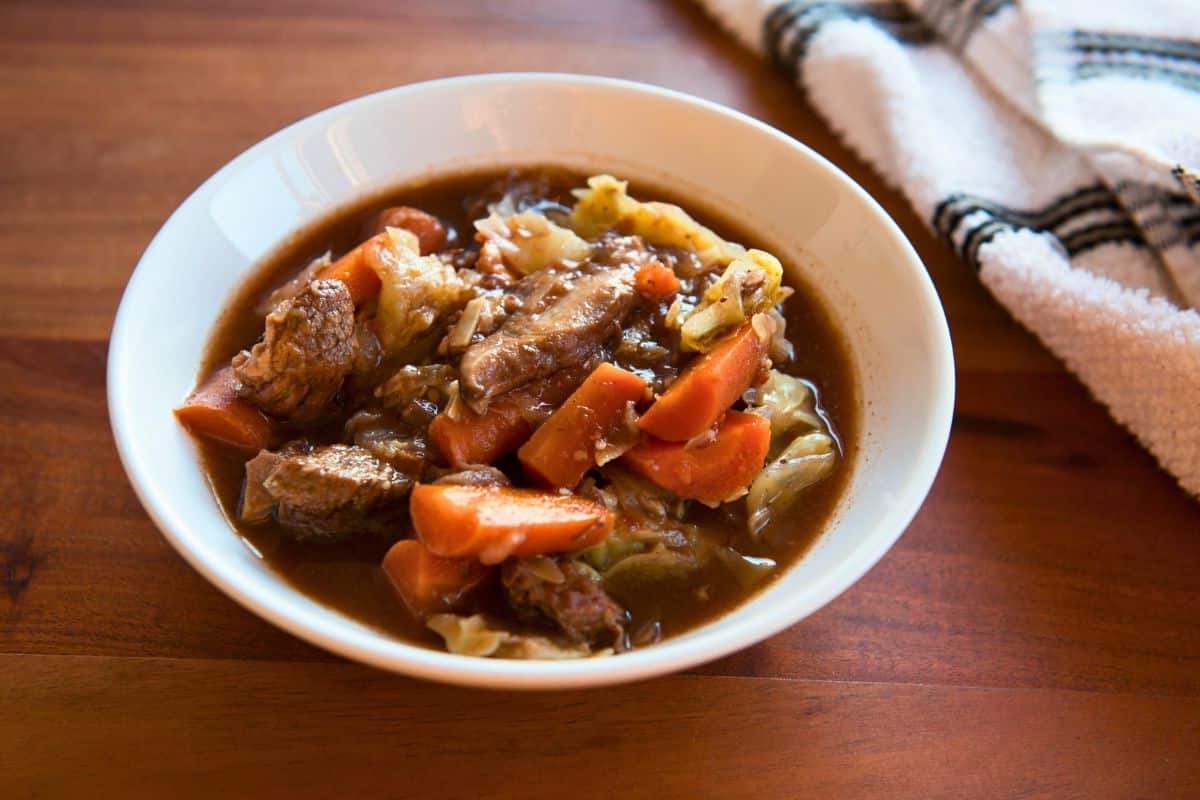This hearty beef and cabbage stew is perfect for a cozy night in. Packed with nutritious vegetables and tender chunks of beef, this dish is both comforting and satisfying. The slow simmering process allows the flavors to meld together beautifully, creating a rich and flavorful stew that will warm you from the inside out.
While most of the ingredients for this beef and cabbage stew are common pantry staples, you may need to pick up a few items at the supermarket. Beef stew meat is typically found in the meat section, and you may need to visit the produce aisle for fresh cabbage, carrots, and onion. Make sure to also grab some beef broth and tomato paste if you don't have them on hand.

Ingredients For Beef And Cabbage Stew Recipe
Beef stew meat: Tender chunks of beef that become melt-in-your-mouth delicious when slow-cooked.
Cabbage: Adds a hearty texture and absorbs the flavors of the stew.
Carrots: Provide a natural sweetness and vibrant color to the dish.
Onion: Adds depth and a slight sweetness to the stew.
Garlic: Enhances the overall flavor with its aromatic and savory notes.
Beef broth: The base of the stew, giving it a rich and robust flavor.
Tomato paste: Adds a concentrated tomato flavor and helps thicken the stew.
Salt: Enhances all the flavors in the stew.
Black pepper: Adds a bit of heat and depth to the flavor profile.
Dried thyme: Brings a subtle earthy and slightly minty flavor to the stew.
Technique Tip for This Recipe
When browning the beef stew meat, ensure the pot is hot enough to create a good sear. This will lock in the juices and add a rich depth of flavor to the stew. Avoid overcrowding the pot; brown the meat in batches if necessary.
Suggested Side Dishes
Alternative Ingredients
beef stew meat - Substitute with lamb stew meat: Lamb provides a similar texture and rich flavor, making it a suitable alternative for beef in stews.
beef stew meat - Substitute with mushrooms: For a vegetarian option, mushrooms offer a meaty texture and umami flavor that can mimic beef.
cabbage - Substitute with kale: Kale holds up well in stews and provides a similar texture and nutritional profile to cabbage.
cabbage - Substitute with bok choy: Bok choy has a mild flavor and crisp texture that works well in stews, similar to cabbage.
carrots - Substitute with parsnips: Parsnips have a sweet and slightly nutty flavor that can replace carrots in stews.
carrots - Substitute with sweet potatoes: Sweet potatoes add a different kind of sweetness and a creamy texture to the stew.
onion - Substitute with leeks: Leeks provide a milder, slightly sweet flavor that can replace onions in stews.
onion - Substitute with shallots: Shallots offer a more delicate and sweet flavor compared to onions, making them a good substitute.
garlic - Substitute with garlic powder: Garlic powder can be used in place of fresh garlic, though it has a slightly different flavor profile.
garlic - Substitute with shallots: Shallots can add a mild garlic-like flavor when minced finely.
beef broth - Substitute with vegetable broth: Vegetable broth is a good vegetarian alternative that still provides depth of flavor.
beef broth - Substitute with chicken broth: Chicken broth can be used if beef broth is unavailable, though it has a lighter flavor.
tomato paste - Substitute with crushed tomatoes: Crushed tomatoes can add a similar tomato flavor and thickness to the stew.
tomato paste - Substitute with ketchup: Ketchup can be used in a pinch, though it is sweeter and less concentrated than tomato paste.
salt - Substitute with soy sauce: Soy sauce can add saltiness and umami flavor to the stew.
salt - Substitute with sea salt: Sea salt can be used as a direct replacement for table salt, often with a slightly different mineral content.
black pepper - Substitute with white pepper: White pepper provides a similar heat but with a slightly different flavor profile.
black pepper - Substitute with cayenne pepper: Cayenne pepper can add heat, though it is spicier than black pepper.
dried thyme - Substitute with dried oregano: Dried oregano has a similar earthy flavor that can replace thyme in stews.
dried thyme - Substitute with dried rosemary: Dried rosemary offers a robust flavor that can substitute for thyme.
Other Alternative Recipes Similar to This Stew
How To Store / Freeze This Stew
Allow the beef and cabbage stew to cool completely before storing. This helps prevent condensation, which can lead to a watery stew.
Transfer the cooled stew into airtight containers. For easy portion control, consider using individual serving-sized containers.
Label each container with the date of preparation. This ensures you keep track of freshness and consume the stew within a safe timeframe.
Store the containers in the refrigerator if you plan to consume the stew within 3-4 days. The beef and vegetables will maintain their texture and flavor during this period.
For longer storage, place the airtight containers in the freezer. The stew can be frozen for up to 3 months without significant loss of quality.
When ready to reheat, thaw the frozen stew in the refrigerator overnight. This gradual thawing helps preserve the texture of the cabbage and carrots.
Reheat the stew on the stovetop over medium heat, stirring occasionally to ensure even heating. Alternatively, you can use a microwave, heating in short intervals and stirring in between.
If the stew appears too thick after reheating, add a splash of beef broth or water to reach the desired consistency. Adjust seasoning as needed before serving.
How To Reheat Leftovers
Stovetop Method: Place the leftover beef and cabbage stew in a pot over medium heat. Stir occasionally to ensure even heating. Add a splash of beef broth if the stew has thickened too much. Heat until the stew is steaming hot and the beef chunks are warmed through.
Microwave Method: Transfer a portion of the stew to a microwave-safe bowl. Cover with a microwave-safe lid or plastic wrap, leaving a small vent for steam to escape. Heat on high for 2-3 minutes, stirring halfway through. Continue heating in 1-minute increments until the stew is hot.
Oven Method: Preheat your oven to 350°F (175°C). Place the leftover stew in an oven-safe dish and cover with aluminum foil. Heat for about 20-30 minutes, or until the stew is thoroughly warmed. Stir halfway through to ensure even heating.
Slow Cooker Method: If you have a bit more time, transfer the leftover stew to a slow cooker. Set it on low and heat for 1-2 hours, stirring occasionally. This method is great for maintaining the stew's rich flavors and tender texture.
Double Boiler Method: For a gentle reheating option, place the stew in a heatproof bowl over a pot of simmering water. Stir occasionally until the stew is heated through. This method helps prevent overcooking and keeps the vegetables from becoming too mushy.
Best Tools for This Recipe
Large pot: A large pot is essential for browning the beef and simmering the stew. It should be big enough to hold all the ingredients comfortably.
Wooden spoon: A wooden spoon is perfect for stirring the ingredients without scratching the pot.
Chef's knife: A chef's knife is necessary for chopping the cabbage, slicing the carrots, and dicing the onion.
Cutting board: A cutting board provides a safe and stable surface for chopping vegetables and meat.
Measuring spoons: Measuring spoons are used to measure out the tomato paste, salt, pepper, and thyme accurately.
Measuring cup: A measuring cup is used to measure the beef broth to ensure the correct amount is added to the stew.
Garlic press: A garlic press makes mincing the garlic cloves quick and easy.
Ladle: A ladle is useful for serving the hot stew into bowls.
Tongs: Tongs can be handy for handling the beef chunks while browning them.
Timer: A timer helps keep track of the simmering times to ensure the stew is cooked perfectly.
How to Save Time on Making This Stew
Pre-cut vegetables: Chop the cabbage, carrots, and onion in advance and store them in the fridge to save time during cooking.
Use a pressure cooker: Speed up the cooking process by using a pressure cooker instead of simmering on the stove.
Batch cooking: Double the recipe and freeze half for a quick meal later.
Pre-marinade meat: Marinate the beef stew meat the night before to enhance flavor and reduce prep time.
Ready-made broth: Use store-bought beef broth to cut down on preparation time.

Beef and Cabbage Stew
Ingredients
Main Ingredients
- 1 lb Beef stew meat cut into chunks
- 1 head Cabbage chopped
- 2 Carrots sliced
- 1 Onion diced
- 3 cloves Garlic minced
- 4 cups Beef broth
- 2 tablespoon Tomato paste
- 1 teaspoon Salt to taste
- 0.5 teaspoon Black pepper to taste
- 1 teaspoon Dried thyme
Instructions
- 1. In a large pot, brown the beef stew meat over medium heat.
- 2. Add the diced onion and minced garlic, cook until softened.
- 3. Stir in the tomato paste, beef broth, salt, pepper, and thyme.
- 4. Bring to a boil, then reduce heat and simmer for 1 hour.
- 5. Add the chopped cabbage and sliced carrots, simmer for another hour.
- 6. Adjust seasoning to taste and serve hot.
Nutritional Value
Keywords
Suggested Appetizers and Desserts for This Stew
More Amazing Recipes to Try 🙂
- Coconut Custard Pie Recipe1 Hours
- Rumchata Pudding Shots Recipe10 Minutes
- Butter Pecan Ice Cream Recipe45 Minutes
- Hello Dolly Bars Recipe35 Minutes
- Roquefort Pear Salad Recipe15 Minutes
- Stewed Apples Recipe30 Minutes
- Chocolate Cherry Cake Recipe55 Minutes
- Canned Apple Pie Filling Recipe45 Minutes


Leave a Reply